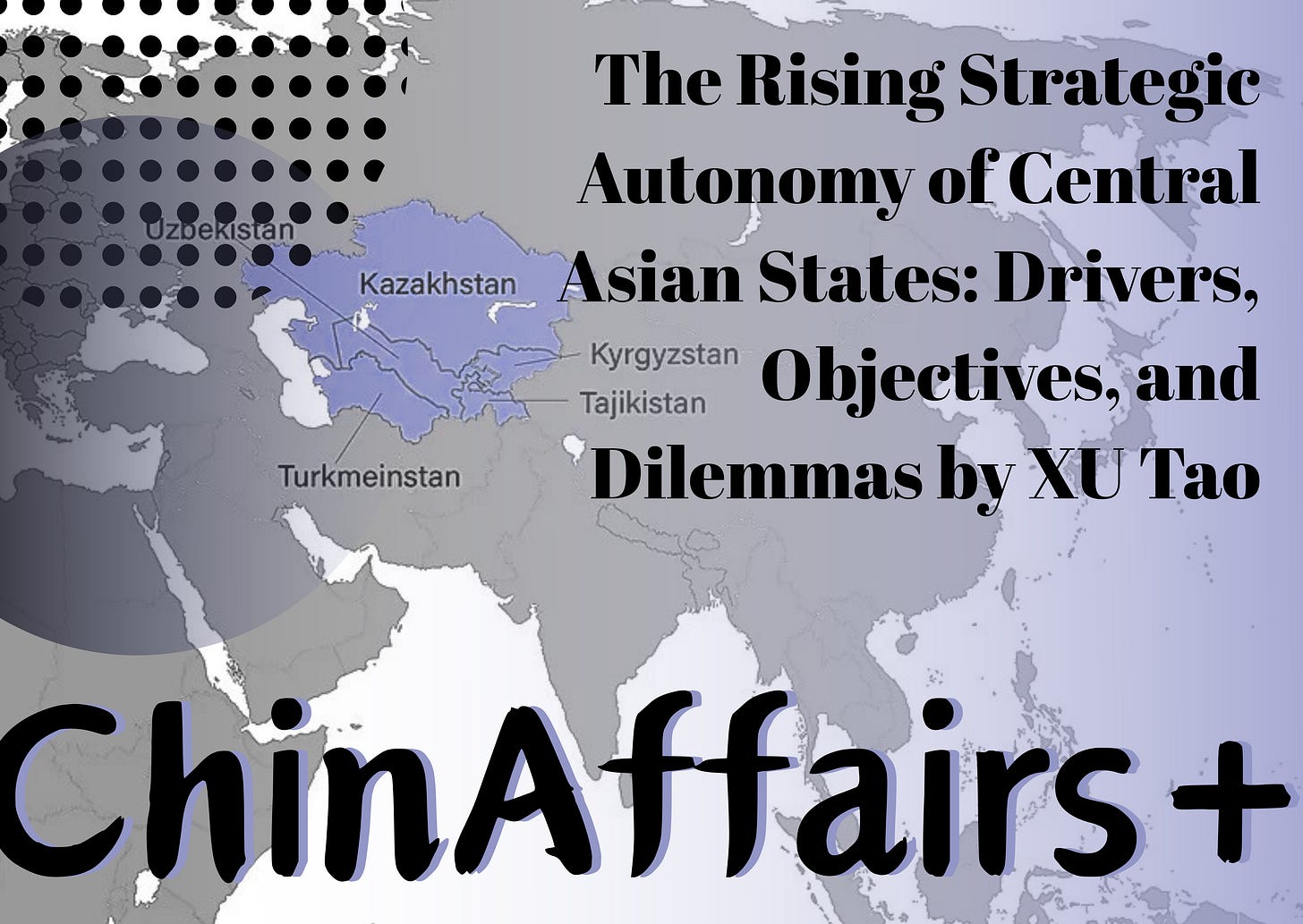The Rising Strategic Autonomy of Central Asian States: Drivers, Objectives, and Dilemmas by XU Tao
As major power rivalries and conflicts escalate regionally and even globally, Central Asia, long considered an “in-between” zone, is increasingly becoming the focus of great power competition.
Welcome to the 53rd edition of our weekly newsletter! I’m SUN Chenghao,a fellow with the Center for International Security and Strategy (CISS) at Tsinghua University, Council Member of The Chinese Association of American Studies, a visiting scholar at Paul Tsai China Center of Yale Law School in 2024 and Munich Young Leader 2025.
ChinAffairsplus is a newsletter that shares articles by Chinese academics on topics such as China's foreign policy, China-U.S. relations, China-Europe relations, and more. This newsletter was co-founded by my research assistant, ZHANG Xueyu, and me.
Through carefully selected Chinese academic articles, we aim to provide you with key insights into the issues that China’s academic and strategic communities are focused on. We will highlight why each article matters and the most important takeaways. Questions and feedback can be addressed to sch0625@gmail.com
Today, we have selected an article written by XU Tao on The Rising Strategic Autonomy of Central Asian States: Drivers, Objectives, and Dilemmas.
Summary
Since the collapse of the Soviet Union in the early 1990s, the five Central Asian states have embarked on the historic process of building independent nation-states, a process that has now been ongoing for 34 years. During this period, each country has chosen development paths suited to its own characteristics, established highly centralized and efficient presidential systems, and reconstructed relatively complete supply and industrial chains from the ruins of the collapsed Soviet economic system.
At the same time, through diversified and balanced foreign policies, they have maintained constructive interactions with the international community. Due to the region’s unique geopolitical position, bordering today’s global geopolitical center of gravity and several conflict hotspots, major external shocks in surrounding areas have inevitably exerted specific impacts on the political stability and economic development of the five states.
However, as their political, economic, and security capacities have steadily improved since independence, the extent to which their policy choices and development models are constrained by external forces has gradually diminished. In recent years in particular, profound shifts in the international order have been reshaping the geopolitical structure of Eurasia. These changes have, on the one hand, compelled Central Asian countries to accelerate the closing of institutional and policy gaps and to enhance their overall capacity to manage risks and uncertainties. On the other hand, unprecedented adjustments in the global balance of strategic power have also created conditions incentivizing greater strategic autonomy.
As major power rivalries and conflicts escalate regionally and even globally, Central Asia, long considered an “in-between” zone, is increasingly becoming the focus of great power competition. Furthermore, accelerated social transformation within Central Asian countries and efforts to repair positive relations among them have elevated their confidence to the highest level since independence. This represents one of the most significant new regional variables since the dissolution of the Soviet Union, and its impact will be both profound and complex.
Why It Matters
In recent years, Central Asian states have steadily enhanced their autonomy in political, economic, and social spheres. By pursuing diversified diplomatic strategies, deepening regional cooperation mechanisms, and improving institutional development, they have gradually secured a more prominent voice on the international stage.
Against the backdrop of the protracted Russia-Ukraine conflict and the intensifying geopolitical rivalry between the United States and China in Eurasia, Central Asia has shifted from being a traditional “buffer zone” to becoming an important participant in both competition and cooperation among major powers. At the same time, the region’s role in energy development, transport connectivity, and regional security governance has become increasingly significant, positioning Central Asia as a vital bridge between Europe and Asia.
This article seeks to analyze the drivers, objectives, and dilemmas of Central Asian states’ pursuit of strategic autonomy. It further explores how these states strive to chart relatively independent development paths under complex international circumstances. The study not only responds to growing global focus on Central Asia’s strategic role but also offers valuable insights and policy implications for understanding how small and medium-sized countries can achieve balanced development in a multipolar world order.
Key Points
Despite the presence of various ethnic regimes with their own territorial control and influence throughout Central Asia's ancient and modern history, the construction of modern nation-states in the region began only after the dissolution of the Soviet Union in 1991. After the "August Coup," which is regarded as the catalyst for the Soviet Union's political disintegration, Central Asian republics declared independence between late August and October 1991 and introduced their first constitutions. However, it was not until December 25, when Gorbachev resigned and the Supreme Soviet held its final session, that the Soviet Union officially ceased to exist.
Central Asian leaders, including Kazakhstan’s Nazarbayev, displayed a contradictory attitude towards the dissolution. On one hand, they rejected joining a small group led by Yeltsin, Shushkevich, and Kravchuk signing off on the dissolution of the Soviet empire, but on the other, they eventually accepted the Belovezh Accords that sealed the USSR’s disintegration. This complex psychological state was shared by many leaders in the region who both rejected Soviet centralization while fearing the loss of political, economic, and security protection from the Soviet system.
The Fundamental Drivers for Central Asian States in Seeking Strategic Autonomy
After 34 years of independence, Central Asian states have largely rebuilt their political systems and economies, a process that has been more challenging than expected due to the need to reassemble the remnants of the Soviet Union’s centralized political and economic structure.
The Major Challenge for Central Asian Leaders: Defining the Type of State to Build
Throughout the region, the presidents' powers were greater than those of parliaments or governments. Despite various reforms and political struggles, these countries have strengthened their political systems, largely fulfilling their primary missions: breaking away from the Soviet political framework, preventing further social fragmentation, and rescuing national economies. Entrenched interest groups centered around presidential families have also made the process of power transition complex and unpredictable. Through a prolonged process of exploration, national leaders have introduced different social reform policies to achieve generational handovers distinct from their predecessors. Different forms of political reform have received strong support from the domestic public, which has also strengthened the confidence of Central Asian leaders in exploring nation-building paths with their own characteristics.
The Need to Immediately Reconstruct National Economies post-Independence
Rebuilding an independent national economic structure from the broken Soviet-era industrial and supply chains proved even more challenging than breaking free from the old planned economy system. In the early years of independence, Central Asian countries, no longer supported by the Soviet central budget, had to start managing their own economies. As newly independent economies, they faced unprecedented difficulties due to the mono-industrial nature of their economies under the Soviet system. From 1992, key economic indicators saw a steep decline, with inflation reaching as high as 2000% by 1995. In response, they began market-oriented reforms, including price liberalization, privatization, and currency independence. By the early 2000s, most countries emerged from economic decline, and in recent years, Central Asia has experienced significant growth, with GDP surpassing $500 billion in 2024.
The Key Task for Central Asian States: Defining Their Role in the International Community and Building Constructive Relations with Major Powers
Due to its unique geographic position, Central Asia has faced challenges in integrating with the world. On one hand, its landlocked location has historically hindered active engagement with the world’s other civilizations. On the other hand, located at the crossroads of major civilizations, it became a focal point for powerful empires such as Alexander's, the Huns, the Mongols, and the Soviet Union. After the Soviet Union's collapse, Central Asian states, seeking recognition and international aid, adopted balanced multilateral foreign policies. Kazakhstan, Uzbekistan, Kyrgyzstan, Tajikistan, and Turkmenistan developed distinct foreign policies based on these strategic needs.
The formation of balanced multilateral foreign policies by Central Asian states has been a dynamic process, undergoing adjustments in the more than thirty years since independence. Through this experience, these countries have not only created necessary international space but have also gained valuable insights. In the last decade, the global balance of strategic power has been undergoing structural changes, which were further accelerated by the escalation of the Ukraine crisis in 2022. Central Asia is becoming a strategic space actively sought by major powers. The recent “C5+1” summit upgrades reflect this newfound influence and Central Asia's increasing geopolitical importance.
The Main Goals of and Pathways for Pursuing Strategic Autonomy
Having consolidated political, economic, and cultural sovereignty, Central Asian states still lack the proactive capacity to respond to sudden regional and international changes due to their historical legacy and geopolitical constraints; however, after over thirty years of independence, they have been actively seeking feasible paths toward their primary goals in the past decade.
Establishing an Independent Cultural Value Systems
Due to its unique history, Central Asia's cultures are fragmented, shaped by multiple foreign influences. After gaining independence, Central Asian countries focused on building national identities centered around indigenous cultures. Turkmenistan's first president, Niyazov, wrote Ruhnama, which became a key cultural guide, promoting national pride and citizenship. Kyrgyzstan celebrated its Manas epic as a symbol of national identity, and Uzbekistan emphasized its “Third Cultural Renaissance.” Kazakhstan highlighted its historical connection to the Golden Horde. These efforts aimed to rebuild cultural confidence and national identity post-Soviet Union.
Shaping a Favorable Environment for Regional Integration
Central Asia faces many resource-based challenges that transgress national borders, such as those surrounding water, minerals, and infrastructure. The Soviet-era borders often caused disputes post-independence. In response, leaders gradually recognized the need for cooperation to break the cycle of conflicts. In 2018, the Central Asian leaders established a consultative meeting platform to address these issues. By resolving complex border disputes and focusing on shared history and resources, the region is moving toward better integration, with Kazakhstan's initiatives promoting cultural and historical tourism to enhance regional ties.
Actively Participating in Regional and Global Governance Issues
As nation-states evolve, Central Asian countries are increasingly engaged in global and regional issues. At the 2019 UN General Assembly, Kazakhstan's President Tokayev highlighted global threats, including regional conflicts and climate change. Similarly, Kyrgyzstan and Uzbekistan have prioritized climate resilience and cross-regional cooperation. Uzbekistan hosted the 150th World Parliamentary Union conference and promoted dialogue on regional security, particularly regarding Afghanistan. These countries actively shape global discourse by hosting summits and engaging in multilateral diplomacy, further strengthening their international presence.
Issues Still Preventing Central Asian Countries from Achieving Strategic Autonomy
Despite the significant achievements in the development of Central Asian countries over the past three decades, the region's geopolitical challenges and external influences continue to complicate the process of achieving strategic autonomy, making it a gradual and complex undertaking.
Central Asian Countries’ Exhausting of Resources to Secure Stability and Rebuild Economies After Independence
In the early years of independence, Central Asian countries established centralized presidential systems to counter extremism, relying on energy and minerals to prevent economic decline and using populism to promote national identity. These short-term measures created entrenched elite networks, concentrated wealth, and led to uneven development. Over-reliance on resource extraction placed the economy at the lower end of the global supply chain and caused environmental deficits. Population growth policies increased the population by a third, resulting in labor oversupply, high migration outflows, and difficulties in employment and poverty reduction, limiting capabilities for long-term strategic autonomy.
The Persistent Influence of Russia: a Reality Central Asian Countries Cannot Ignore
Spanning the 1822 Siberian Governor-General’s decree on the "West Siberian Kyrgyz Law" and the dissolution of the Soviet Union in 1991, Russian political and cultural influence on Central Asia lasted for 170 years. This not only brought Slavic and Orthodox culture but also European industrial civilization and market concepts into the region’s long-isolated societies. Despite the Soviet collapse, these historical ties still shape Central Asia's foreign policy, with countries maintaining a complex and ambivalent relationship with Russia, balancing sovereignty concerns and historical ties.
Focus on U.S. and EU Influence Post-Independence as a Tool for Diplomatic Balance
When the U.S. and Europe began to pursue geopolitical goals in Central Asia, such as countering Russia, curbing South Asian extremism, and transforming the post-Soviet space, they adopted an inclusive approach. However, their democracy-driven soft power initiatives often clashed with regional realities, leading to resistance from Central Asian states. Despite this, U.S. engagement continued with initiatives like the "C5+1" dialogue. As the region's geopolitical tensions escalated, the EU and U.S. adjusted their policies. However, uncertainty arising from internal politics is bound to drive significant fluctuations in Central Asian countries’ balancing foreign policies.
Conclusion
Over the past thirty years, the construction of independent nation-states in Central Asia has steadily progressed. However, after the Cold War, the accumulation of regional tensions in Eurasia has recently led to a concentration of conflicts. This overall context has fostered a growing awareness among Central Asian political elites about the need for strategic autonomy, and they have made clear attempts to achieve it. This emerging trend is one of the most significant variables in the region today, likely to catalyze shifts in both internal and external relations. Predictions suggest that, first, this burgeoning strategic autonomy will contribute to Central Asia becoming a stable, unified geopolitical bloc. Second, due to historical and practical constraints, this process will be slow and gradual. Third, this trend aligns with broader regional goals, promoting long-term cooperation and the formation of a shared future. This dynamic cooperation will help address uncertainties and contribute to shared development.
About the Author
XU Tao 许涛: Deputy Director of the Institute for Eurasian Social Development at the Development Research Center of the State Council, Director of the Central Asia Research Division, Senior Researcher, and Executive Director of the China Shanghai Cooperation Organization Research Center.
About the Publication
The Chinese version of the article was published by Russian Studies《俄罗斯研究》, supervised by the Ministry of Education of the People's Republic of China and edited and published by the Russia Research Center of East China Normal University. The target audience includes experts and scholars engaged in the study of political and economic issues in Russia, Eastern Europe, Central Asia, and other regions, as well as decision-makers at all levels, foreign trade enterprises and individuals, foreign affairs workers, faculty and students at universities, and researchers in research institutions.










